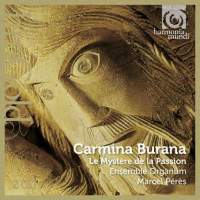Texte paru dans: / Appeared in: |
|
|
Outil de traduction (Très approximatif) |
|
|
|
|
|
Reviewer: J.
F. Weber The latest production developed by this remarkably enterprising group is a close relative of the Passion Play realized by Thomas Binkley and recorded twice in a short time (Fanfare 8:2, p. 321). The play occupies six pages close to the end of the celebrated manuscript, and Binkley found that many of the incipits in the play called for the insertion of well-known pre-existing chants. Hence he brought it to life for the first time in a staged production at The Cloisters in New York and then at the Schola Cantorum in Basel. Yet he provided no hint of when the play might have been performed. In this new approach, Pérès finds enough Palm Sunday responsories at the beginning of the play (Binkley omitted most of them) to suggest that the play began during the Palm Sunday procession before Mass. He takes the play up to the agony in the garden (after the Last Supper), and at this point inserts the chants of the first part of the Palm Sunday Mass (Introit, Gradual, Tract). The play then continues, apparently, as a dramatized version of the gospel (as always, until recent times, Matthew's account of the Passion). The end of the play (including the Planctus ante nescia) is non-scriptural and non-liturgical, and it can be taken as a pendant to the gospel. Finally, Pérès frames the whole play with two magnificent hymns of the season, Vexillä Regis at the beginning (it belongs to the time beginning a week before Palm Sunday) and Crux fidelis (properly for the Good Friday service at the adoration of the Cross) at the end. At two and a half hours, this is more than an hour longer than Binkley's realization, but granted the correctness of the director's assumptions, it makes the production much more concrete, situating it as it might have been performed when it was new. I hear a lot of good things in the transcription. I couldn't explain Binkley's florid rendition of Pilate's Ecce homo, which is notated in the manuscript simply with a virga on each syllable; Pérès gives it the expected four high notes. The liturgical chants are performed in a peculiar fashion, given Pérès's previous recordings. I hear no single system of interpretation; the singing of the Tract is easily the closest to a standard chant interpretation, while the opening and closing hymns are metrical in the style demonstrated by Konrad Ruhland in several recordings, and the other chants vary both in melody and rhythm, according to the soloist assigned, in ways that I can't identify with any certainty. Worst of all, the Introit of Palm Sunday (and those for the rest of Holy Week) has always been sung without the doxology, but Pérès adds it here in an AVAGA format. I think the dirge-like conclusion of Crux fidelis out of character (it's so slow that Pérès includes only the first three verses and the concluding one); this hymn celebrates the triumph of the Cross, as its text proclaims, the victory of the Savior and his people over sin and death, and a rousing approach to the metrical rhythm would have been quite stunning. The sound is clear and balanced, made at the abbey of Ambronay last year following a festival performance. The notes are adequate, although much more might have been said, and texts with three translations are very easy to follow. Pérès admits that he has composed several short passages that lack notation, and also identifies the sections that he has transcribed directly from the staffless neumes in the manuscript (rather than from cognate sources, mostly liturgical). This makes a useful comparison with Binkley's version, which I hope to see on CD as soon as the other Harmonia Mundi's new distributors get around to it (EMI never did). Recommended, with further study advisable. | |
|
|
|
|
|
|
|
Cliquez l'un ou l'autre
bouton pour découvrir bien d'autres critiques de CD |
|




